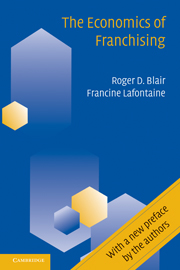Book contents
- Frontmatter
- Contents
- Preface
- 1 Introduction
- 2 Four Popular Misconceptions about Franchising
- 3 Franchise Contracts
- 4 Franchising, Vertical Integration, and Vertical Restraints
- 5 Quality Control
- 6 Franchise Tying Contracts
- 7 Vertical Price Controls in Franchising
- 8 Encroachment
- 9 Advertising and Promotion
- 10 Termination and Non-Renewal
- 11 Concluding Remarks
- Articles, Books, and Other Publications
- Cases, Codes, and Statutes
- Index
11 - Concluding Remarks
Published online by Cambridge University Press: 24 May 2010
- Frontmatter
- Contents
- Preface
- 1 Introduction
- 2 Four Popular Misconceptions about Franchising
- 3 Franchise Contracts
- 4 Franchising, Vertical Integration, and Vertical Restraints
- 5 Quality Control
- 6 Franchise Tying Contracts
- 7 Vertical Price Controls in Franchising
- 8 Encroachment
- 9 Advertising and Promotion
- 10 Termination and Non-Renewal
- 11 Concluding Remarks
- Articles, Books, and Other Publications
- Cases, Codes, and Statutes
- Index
Summary
Introduction
Franchising entails a symbiotic relationship between what are, in reality, legally independently owned businesses. Franchisees can only succeed when the system as a whole succeeds. At the same time, the franchisor's profits derive from the success of its franchisees. Their mutual interdependence is, therefore, readily apparent. But while the interests of franchisors and franchisees often coincide, it remains true that they are not entirely compatible. This, of course, gives rise to conflict.
Broadly conceived, there are two major sources of conflict between franchisors and franchisees. First, some franchisees are simply ill-suited to being part of a chain where uniformity is essential. These people are just too independent. They want to modify the menu, select a different location, have different hours of operation, and so on. Because franchise systems thrive on uniformity of quality, appearance, hours of operation, and the like, there is a tension between the franchisor and some of its franchisees who chafe under the franchisor's insistence on compliance with the business model. There is no obvious way to resolve this problem except to note that those individuals who seek significant independence should not invest in a franchise, and franchisors also need to develop franchise sales and franchisee selection procedures that will prevent the sale of franchises to such individuals. Not surprisingly, the franchising trade and management consulting literatures discuss this problem at length.
- Type
- Chapter
- Information
- The Economics of Franchising , pp. 291 - 302Publisher: Cambridge University PressPrint publication year: 2005



